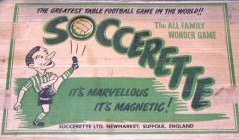
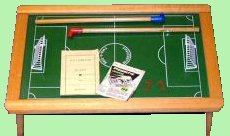
| Peter Upton's |
|
Subbuteo Tribute Website. |
Rival Games 1950s-1970s |
Having produced pages on both Striker and Newfooty, it seemed reasonable to provide a quick round up of other similar football games that appeared on the market in the Subbuteo era.
This is an ongoing section of the website. I have very little detail on some of these games, sometimes little more than a picture or two. So if your second favourite football game is missing, or lacking in details then please write in and tell me about it. Alternatively, if you owned one of these games and it was a complete dog then again, let me know and I'll warn football game collectors!
I've deliberately avoided card games, board games, computer games, and anything with rotating rods. The games here will generally have some degree of action, and individual players.
Magnetic Football Games 1950s-60s.


This seemed to have been a bit of a craze in the 1950s. There were several manufacturers of this type of game, but the principle was the same. Each playing piece had a magnet on the bottom of the base, which was manipulated by a rod which went under the table. The magnets of each team were polarised in reverse, so you could not affect your opponents players with your rod. The players were then used to push the ball around the pitch. Goalkeepers could either be on magnets like the outfielders, or on a rod like Subbuteo. The game boards were pretty similar with a smooth wooden or plastic surface, some form of fence surround, and legs to enable you to get under the pitch.
Well known versions of this game included:
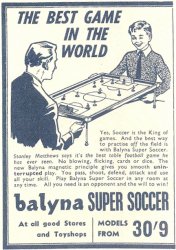
I played a version of this game at the Woking Subbuteo fair, which did not seem to match any of the sets I've seen since. So I am sure there are more to uncover.
Magnetic football is fun and frenetic, and takes a little bit of skill. If you try to move things along too fast, or go for too much power when shooting, then you are liable to leave player or ball, or both behind. Although you couldn't control your opponent's players, your reversed magnet could be used to flip them over if you were sneaky.
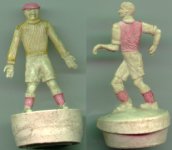
Time has faded these Arsenal players to a fetching
pink.
Maybe this is apt for the player doing the "teapot" impression.
They come from an early Soccerette set.
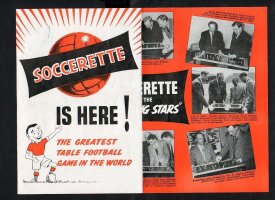

According to Richard Payne's Subbuteo book, Peter Adolph did not actually regard Bayna's magnetic football as a rival, as he thought the two games complimented each other. This might have been because they both had a rival in Newfooty, or because both games came from Kent. I've been told that like Subbuteo and New Footy, Magnetic football had a Players Association, with leagues and tournaments. This is backed up by the illustrated Soccerette Club badge sent in by Ashley Hemmings.
February 2015 - Ashley has now sent in a brochure that helps fill in the details of what was available for Soccerette.
There were three different sizes available - listed here quoting the (not over-the-top at all) sales blurb.
| The Family Model | Constructed in the finest materials with four special, moulded adjustable and detachable legs for easy levelling up and engraved playing field of non-flammable, warp-proof material exclusive to Soccerette design. Fourteen sculptured players in two different team colours with distinctive goalkeepers all on specially polarised and moulded bases. Four Wonder Soccerette Wands. Two balls. Two goals. Size approx 3ft 4ins by 2ft 6ins. |
| The 5-a-side Model | A slightly smaller Soccerette table model.... Ten Sculptured players (etc, etc). Four Wonder Wands. Only one ball, but luckily two goals. Size approx 2ft 7ins by 1ft 9ins. |
| The 2-a-side Model | Not a toy, but another precision-made article. Just four players with this one, and no distinctive goalkeepers. Just two wands, and a single ball. Size approx 1ft 10 3/4ins, by 1ft 4ins. |
In addition, the following accessories were obtainable "at your local stockist"
Balyna Football (the other one!)
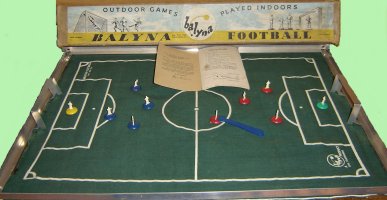
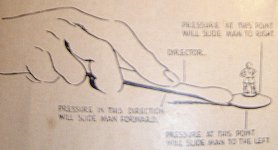
Just to add to the confusion, as well as their magnetic set, Toogood and Jones produced this alternate indoor football game. Unlike the big box required for the "fixed pitch" of their magnetic game, Balyna Football was sold in a long thin box. It has a cloth pitch with a metal surround and goals. The players were on hollow bases and were directed towards the ball with a spoon-like "director". The ball was a flat disc. Hopefully the image from the rules will give you some idea of how this works. There was also a Balyna Cricket game produced in a similar long box format.
A big thank you to Filip Van Hulle who made me aware of this game.
Tipp-Kick (1920s - 2020s)
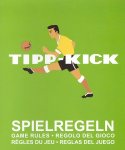
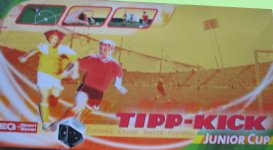
Tipp-Kick is essentially the German version of Super Striker. Well actually, the principle is the same as the Peter Pan Cup Final game shown on the next page of this round-up, but comparing the game to the Peter Pan effort is doing it a disservice. Even calling it the German Super Striker is a little insulting, as Tipp Kick has a history longer than any other game on this website.
As Tipp-Kick is German, and does not seem to have spread to British shores in any numbers, I have really struggled to find information about its history. Luckily, website visitor Ameen Muhairez is bilingual, and has kindly passed on his knowledge of this important football game.
The history of Tipp-Kick begins with a patent for a "football board game" lodged by Karl Mayer, in Stuttgart in 1921. In 1924 he granted a production licence to an export salesman named Edwin Mieg. Mieg then quit his job so he could spend time developing the game, and he presented it to the public for the first time at the Leipzig Toy Fair in 1926. However, Mieg couldn't afford an official stand at the fair, so he set up a stall at one of the entrances and invited the arriving visitors to have a go at this new game. Of course, this activity (along with the resultant crowds), bought Mr Mieg to the attention of the security guards, and he was moved on. Heroically, he then just moved to another entrance and carried on. This dogged determination meant that he managed to sell 200 sets during the day, and confirmed that the game was a marketable product.
The game was firmly established in Germany by the mid 1930s, and Mieg opened his own factory to produce the sets in 1938. Production continues to this day by the Mieg company, with very few changes. See their lovely official Tipp-Kick website/shop if you want to know more.
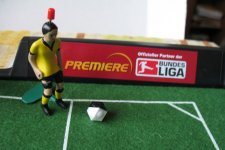
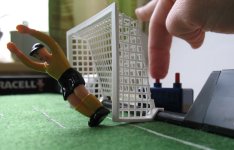
The key component in a Tipp-Kick set is obviously the kicker himself. He is of a metal construction, with a moveable leg, that is used to propel the ball. A metal pin passes through the figure and operates the kicking leg from a button on top of the head. Of course, Tipp-Kick shares this feature with British games Striker, Targetman, Big League, and Cup Final, but the retention of the traditional metal players, even in the 21st century sets, gives it a lovely distinctive look and feel. It is quite remarkable really, in the era of plastic domination, to find figures that would not look out of place in a pre-war lead Britains figure display.
The other components have become plastic over the years, as the pictures from my modern "Junior Cup" set show. Even the goalkeepers in these later sets are plastic. This is a fixed position diving goalkeeper, and is operated using a box behind the goal. Pressing the buttons on the box make the goalkeeper dive. The diving goalkeeper was introduced in 1954, to coincide with the World Cup of that year. More recently, a more sophisticated "star-keeper" has been made available, with the same control box, but a more complicated rod allowing him to "dive forwards". The Star-Keeper appears to be wearing track-suit bottoms, which in my real life experience certainly does not signify a star goalkeeper.
The reason I mentioned Cup Final in my introduction, rather than Striker, is that the Tipp-Kick ball is not round, but instead it is a multi-sided object in two colours. Each team has a colour, and the player whose colour is on top can play the ball. The modern Tipp-Kick rule book (and it seems to cover all forms of the game) states that "A team may consist of up to three kickers and a goalie, however each player may only field one kicker and the goalie at one time", and that "different kickers may be used depending on the game situation". It does not explain more than that though.
As mentioned, the set featured here is a modern "Junior Cup" set. This set features a mid-sized pitch, and a single player per side.
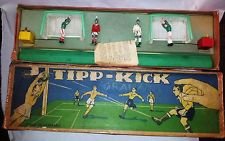
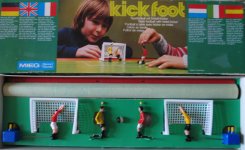
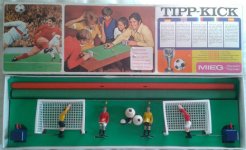
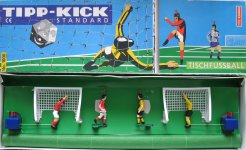
However, it is obvious that with a ninety year history, there are going to be many different sets produced. The most common set is undoubtedly a simple two player set in a long thin box, featuring a horrible roll-up pitch of a papery fibre. The pitch here is even smaller than the Junior Cup version shown above. I've seen quite a few of these sets at toy fairs, but they all have different lids, and there is trouble with dating them, as the contents barely change.
I've seen sets with illustrated box lids that look 1950s (or earlier), but I can't be sure. Another set I've recently acquired looks very 1970s judging from the cover photograph of a kid playing who would happily fit onto any Striker box of the period. This set, called Kick Foot (No 80), is clearly aimed at a continental market, with flags and wording on the lid for German, English, French, Dutch, Italian, and Spanish players.
Despite the multilingual nature of these sets, is is felt that the game was never really marketed outside of Germany, Austria and Switzerland. This was partly because other football games such as Subbuteo were already well established. In Germany, of course, it was far more successful. I've mentioned that the diving goalkeepers were introduced for the 1954 World Cup. Well, As the 1966 World Cup boasted Subbuteo's sales, so the German win of 1954 pushed Tipp-Kick to great heights. Sales in 1954 were over 180,000 sets.
Teams and Accessories.
Again, I have to return to the modern rulebook, which also has adverts for a team and accessory range (in German). These include -
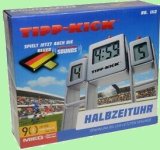
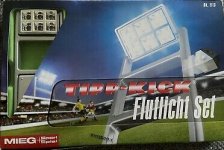
Sets 1111 and 1112.
| Reference No | Description. |
| 6300 | "plastik" pitch 110 x 65 cm |
| 6200 | "velours" pitch 110 x 65 |
| 1310 | Junior Cup pitch |
| 2300/2301 | These seem to be full tables, with a size of 123 x 80 cm |
| 1702 | A pair of goals |
| 1111 | A Tipp-Kick Timer. |
| 1112 | An (improved?) Tipp-Kick timer and scoreboard. Subbuteo would benefit from this. The buttons on the top are the same as those on the players. What a cute way to tie the set into the game. The "sounds" cards provided with certain players (see below) work with this accessory. playing a national anthem. |
| 1113 | A Floodlight set. They look less like real floodlight pylons than the Subbuteo attempts, but have bigger, better lights. |
| 1605 | A pack of five balls. |
| 1203/1204 | Star-Keeper. This has a fancy rod, and allows the goalkeeper to "dive forwards". |
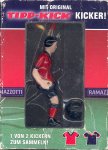

The teams are split into club and international kickers. However, with only one outfield player per side, perhaps calling them a team is a little inaccurate.

The club teams, called "Top-Kicker", were introduced in 1963, to coincide with the formation of the Bundesliga. This range has since expanded to include a good number of the top sides from around Europe. The Liverpool player illustrated demonstrates how standard colours are generally sold - in a bubble on a card.
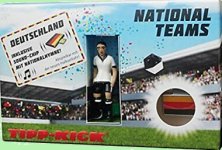
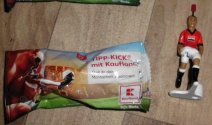
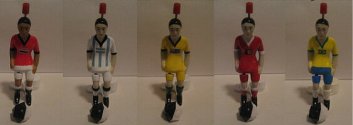
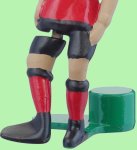
International teams, called "Star-Kicker" arrived for the 1974 World Cup (in Germany of course), and now feature (at least) 46 World Cup teams, ranging from Brazil to Saudi Arabia. The Star-Kicker has a redesigned foot which is "angled to the side and has a larger surface area, making it easier to lift the ball higher". It does make the player look like his foot has been run over by the team bus.... but you can't have everything.
For the 2018 World Cup, all the teams were available (as standard kickers) in "blind bags", making collecting and swapping the order of the day. The teams were in pretty generic versions of their kits, with each countries flag printed centrally (so you knew who your unofficial team was supposed to be!). England were available in their 2016-17 Nike kit - with the sky blue trim and red socks. "Blind bag" collecting is something that I and others have advocated for Subbuteo. So I wonder how successful this was.....
Also shown above is a boxed German "National team" with sound chip. The sound chip (shaped like a flag) works with the scoreboard shown above. The chips play the national anthem of the appropriate team. There is a big box here, but I don't know if you received anything else in it.

In 2011 female Tipp-Kick figures were introduced for the first time to celebrate the Women's World Cup finals being held in Germany. I guess they finally needed to make a new mould..... Painted to Brazil and Germany I think.
The website also has equipment for "professional" tournaments - mirroring the sophisticated products that have been released for table soccer/Subbuteo in the rest of Europe (i.e. metal goals, and professional keepers.
They will also produce promotional items on request, with the name of a company on the pitch, players, fence surround..... The boxed kicker shown at the top of this "team" section is a promotional one - for Ramazzotti, an Italian liqueur. The minimum order for this is one hundred players. It's like Subbuteo's "named box" teams of the 1970s!
Chad Valley Big League. (Early 1970s).
The BIG Football Game with real kicking players.
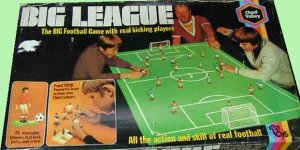

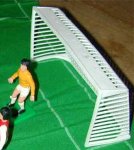
This was more of a rival to Striker than it was to Subbuteo, with large spring-loaded kicking players. It took a more simplified route to kicking than Striker though, with a tab on the kicking leg to allow the leg to be pulled back. The set had large simple plastic goals, and a pitch which was almost identical to a Subbuteo pitch, but even bigger. The "Big" in the title also emphasized that Big League was played with eleven players a side, rather than Striker (and indeed Subbuteo's Targetman) which were only five-a-side. Actually, the Big League box includes 25 players, so you had a few extras (or maybe you could paint a kicking referee!)
The unique selling point for Big League was that the figures were supplied unpainted, and a set of paints and a brush were also included. Another item in the set was a colour wall chart featuring the playing kits of all the English league sides of the time, plus shirts/shorts from Scottish, Irish, and some International sides, to give you a few painting ideas. This is an attractive poster, and it is interesting to see which teams got the Subbuteo treatment and which ones didn't. Of course the downside to this do-it-yourself set is that second-hand you can get some very ropey sets with terrible painting.
I'm not sure how long the sets were produced, but there are at least a couple of slightly different box layouts and I own an alternate version to the set above. Where there is a big black space on the box lid shown here, my set has a drawing of Martin Chivers, with a "Play Big League like I do" speech bubble. The wall chart in my Martin Chivers set is dated to 1973. A bigger change between the two sets is the layout of the box interior. On the set shown above, the two teams face each other in the box, whereas the Martin Chivers version has all the players facing the same way.
The DIY nature of the painting is a downside for the modern collector, but the game also had disadvantages for a 1970s child. For starters the kicking mechanism relied on rather fragile plastic and a tiny spring, but by far the biggest problem with Big League was that there were no specialized goalkeepers. You just had to paint up a standard figure as a goalkeeper. However, that was hardly ideal, and I'm not sure how he was supposed to defend the large goals. This might be because I don't have a rule book with my set.
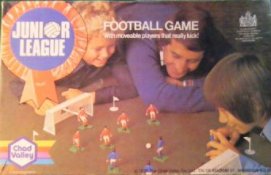
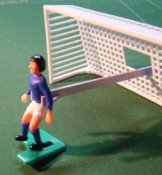
There was also a smaller version produced called Junior League. This set came in a small box, with no pitch, and five-a-side teams. The players in this set were actually pre-painted in blue and red kit, so second-hand teams from this set are much nicer than the paint-yourself ones. Pleasingly, Chad Valley also improved the goalkeeper situation. Although you still had to use an outfield player, there was now a goalkeeper handle featuring a grip which clipped around the waist of one of the players. A small rectangular hole in the back of the goal allowed for some movement of the 'keeper from behind the goal.
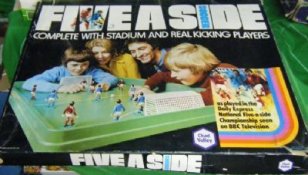
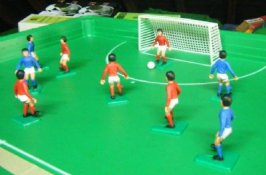
Five-a-Side Soccer was yet another variation on Big League. As with Subbuteo's Football Express, this game was advertised "as played in the Daily Express National Five-a-side Championship seen on BBC Television". This set had the printed red and blue players from Junior League, but probably pre-dated that game, as the old "non-goalkeepers" problem is in evidence. What the box advertised as a "stadium" was (perhaps inevitably) a tacky all-in-one plastic playing surface and surround.
Super Glocagoal by Atlantic (1970s)
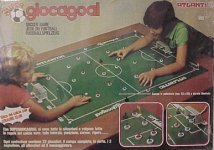
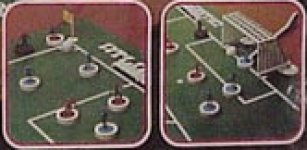
Atlantic were an Italian firm, best known in the UK for producing OO scale plastic soldiers. I can remember shelves full of their figures at Beatties in Brighton, and they had a much wider range of subject matter than their English rivals with Egyptians, Greeks, Wild West etc. I never saw this footie game though, and know little about it.
Looking at the way the kids on the box are flicking the players, and then looking at this blow-up of the action pictures on the box lid suggests that this game was pretty close to Subbuteo (although the ball is smaller). In Italy it was regarded as a cheaper alternative to Subbuteo.
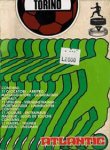

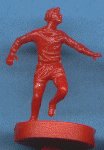
Extra teams were sold in Italy, but these were unpainted, and simply supplied in an appropriate colour plastic. For example, the Torino set shown was dark red. The figures themselves were an OO scale version of the famous Airfix footballers set, which Airfix themselves only produced in 1:32 scale. It was common for other figure manufacturers to "borrow" figure designs from their competitors. The advantage to using the Airfix figures, is that it produces some lovely detailed figures (even if the team includes a referee, linesman and trainer!). These figures would look great alongside Subbuteo's accessories. Another amusing thing is that the goalkeeper is in a diving pose, but he's really only going to be useful diving in one direction.
Interestingly, Airfix did produce a football game in the 1970s, which was in their toy range, rather than the more famous model one. Sadly, the game seemed to be more of a two-player pinball, with the players controlling paddles on the goal line. So it doesn't warrant a place on this page.
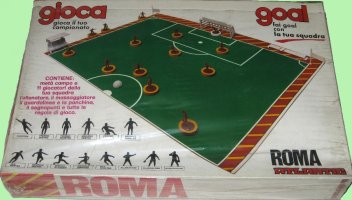
April 2008: New information about the Atlantic set has kindly been sent to the site by Bruno Biasini, who owns the Roma set shown above. Unlike the big set shown at the top of the section, the game at this time came as half a pitch, with one team. Bruno thinks this was smart marketing because in order to have a full game you needed to buy two sets, and he owned Roma and Lazio. The team colours around the pitch-half are a nice touch.

Here are a few bits of the box illustration in more detail. You should be able to see that the (very small) goal, and the flags are different from the "Super" set shown at the top of this section. The little score boards had a sliding marker, and went up to ten. Bruno explains that the winner was simply the first one to ten goals. The set came with two different types of ball. The "Super set shows the small round version, whereas this box shows the larger ball, which was flat on side. With the flat bases, this would have given the game even more of a shove-ha'penny feel. Of course, the best thing shown in this set is the lovely little covered bench.
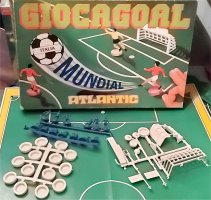
Here is an alternative box set for Giocagoal. The design of the box looks newere, and more compact. You can see from the contents that the extras like the flags and the bench were supplied on the same sprue as the goals.
That's all for this page, but look at Page Two for Cup Final, and loads of Pro-Action Football !!